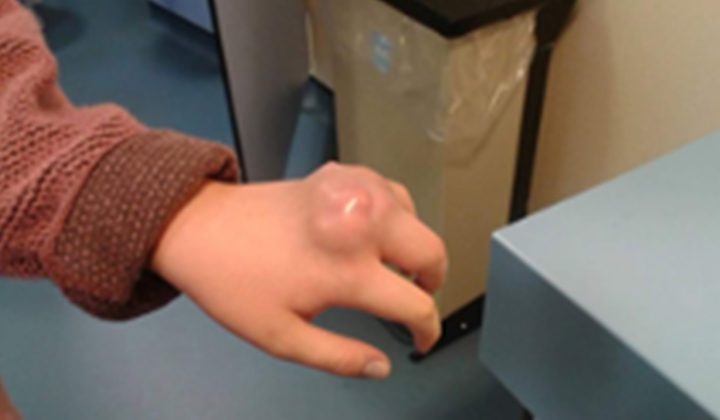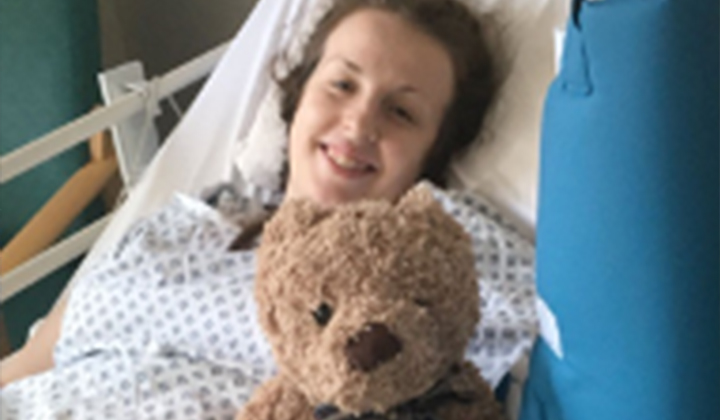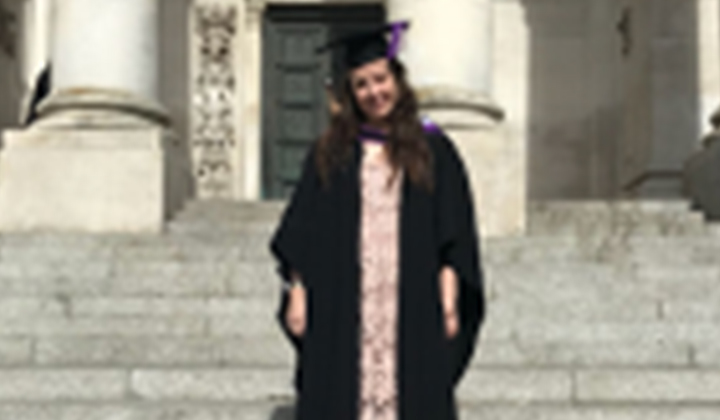
Megan's thrombosis journey began shortly after starting chemotherapy treatment for a rare tumor on her hand.
Hi all! My name is Megan and I’m 25 years old.
For me, it all started with the growth of a rare tumor on my left hand, called an Aggressive Fibromatosis and who my circle referred to as ‘Tulisa tumor’. After trying various treatment options including previous surgery and 9 months of a hormone therapy called Tamoxifen which had been unsuccessful in stopping recurrence and controlling growth, the week after I finished my degree in May 2018, I agreed on the recommendation of oncologists that I would soon begin weekly intravenous chemotherapy treatment which would likely last a year. I had been told that the treatment would most likely cause only mild symptoms and I could continue living a near to unchanged life, so I felt ready to go for it and take down Tulisa!
10 days into my treatment, I had unexpectedly reacted very badly to the chemotherapy and had already visited hospital twice outside of treatment sessions after developing neutropenic sepsis (I had an infection and my immune system was not strong enough to fight it). I began also to experience a persistent dull ache in my right arm, which progressively worsened over the hours and day which followed. I remember feeling extremely agitated and irritable due to the pain as I couldn’t at all pinpoint where it was coming from. Sometimes it felt like my shoulder blade, sometimes my elbow, sometimes within my upper arm but it was unlike anything I'd experienced before so I doubted it was muscular. I was also unable to concentrate on anything other, which upset me as I was trying to watch the classic Made in Manhattan. To this day, I struggle to watch it as it takes me back to that time.
Being an avid watcher of all medical shows such as 24 Hours in A&E but also having a strong inkling that something just wasn’t right, I went to A&E where (after many, many, many hours waiting with my mum overnight), I was immediately given an anti-coagulant injection in my stomach as a precaution after a positive D-Dimer test. A positive D-Dimer figure can have several causes but I think being given an anticoagulant is usual protocol if they suspect that you have a DVT, they do not necessarily wait for a scan result. Later that day, a Doppler ultrasound confirmed I had a DVT in my upper right arm and I was admitted to hospital. Although somewhat expected, this diagnosis still came as some shock as I had no typical symptoms such as swelling, warmth or redness, just an annoying and constant dull ache pain.

The pain somewhat subsided quickly and only really lingered for a few days. Naively I initially thought this treatment might need to be continued daily for a few days or for a couple weeks at most. I was unknowingly gearing up for 6 months of these daily injections, with another 3 months of the anti-coagulant tablet Rivaroxaban to treat the DVT and allow time for investigation into the cause. The tablets seemed much easier because I bruise like a peach and my stomach looked like a crime scene whilst I continued with the injections. I had unsightly but common painful hematomas (areas of collected blood under the skin) all over my stomach and it became impossible to find an unbruised piece of skin to administer the next dose. At one point, the dosage meant I had to do 2 injections daily, something which naturally did not thrill me but really was only a tiny inconvenience. So many people less fortunate must do this every day, several times, for their entire lives. I reminded myself that I’m the lucky one!
Something that also concerned me was the risk of bleeding with anticoagulation medicine. I developed ways to cope with the risk, some for example as little as shaving my legs as close to my next dose as possible, in case I accidently cut myself and started to bleed. I also carried a little alert card with me in case I was involved in an accident (they give you one of these with every prescription you collect, which indicates how important it is to carry it). One of the most worrying times for me came around 6 weeks after my DVT diagnosis when I needed surgery to treat my tumor. Doctors had to estimate the best time to stop and restart taking my anticoagulant medicine the day before and after surgery so I wouldn’t bleed excessively during my operation but also not be covered at all and risk another clot. Surgery went well and I was soon enough back on the anticoagulation treatment which gave me a lot of relief. Although I did not want to be on medication, it became a kind of safety blanket with which I felt safer and protected against the risk of another nasty clot.
Time passed and after a couple of months, I underwent blood tests & CT scans to search for reasons to explain why this had happened. As the doctor noted, they all came back as ‘unremarkable’ and it continued to be a mystery. I am young. I have always been active. I do not smoke. I was not taking a contraception known to be a risk factor. I have no diagnosed genetic condition such as Factor V Leiden. I have not been diagnosed with a clotting disorder. Although unwell, I had not been bed ridden. The chemotherapy was not administered via a PICC line which I also understand to be a risk but rather a new cannular was to be placed weekly. Tamoxifen, the hormone medicine I had previously taken which is a known risk factor had not caused one whilst I had taken it. At first, I had none of the most obvious provoking risk factors.
Healthcare professionals have since agreed that the DVT in my arm was most probably caused by several small contributing factors, including more rest than usual due to illness, a family history of DVT in one of my grandparents & treatment using chemotherapy agents. They did acknowledge however, that the site of the thrombus in my arm was the more uncommon and puzzling aspect of my case and is still largely unexplained.
For me, it is just as important to acknowledge the psychological effects that a DVT has on life beyond the obvious physical symptoms. Since my DVT, it has always been a concern that my risk of developing another is elevated. During treatment, I pondered a lot about how I would feel when I no longer needed to take the medication. After reading accounts from other sufferers, I realize I felt similarly to lots of people and often spent time worrying about the possibility of another episode when I no longer had the armour of anti-coagulation. It is a concern that has reduced over time but is still present and a worry that I manage but is always carried with me and I think will be forever.
This has been particularly at the forefront of my mind during the craziness of the last few months. During this time, I have been shielding at home and in following the advice from the government, I did not leave my house for 11 weeks but tried to be as active as possible (obviously thanks to PE with Joe) and pacing around our (very small) garden. Unsurprisingly however, my lifestyle became significantly more inactive and around 6 weeks into the shielding period, I sought help from 111 and subsequently A&E when I suspected, due to a persistently aching leg which was also swollen, that I had developed another DVT. It turned out not to be one but I know that because of my history, I was right to be concerned and if it happened again, I'd be right to be concerned once again.
I now realize that before any of this happened, I had felt completely invincible and had never imagined that I would be at risk of DVT. When it did happen, I remember feeling embarrassed, as if this was something I could have avoided, especially at a young age. I was treated fantastically in hospital but I remember the impression that healthcare professionals were particularly shocked at my age.
I have realized however, through reading on Thrombosis UK that this happens amongst young people too, for so many reasons and sometimes completely unprovoked. DVT’s can be completely indiscriminatory and I feel passionately about raising awareness that everyone carries some risk, regardless of their unlikelihood of getting a DVT. Awareness of the symptoms and early treatment are essential! Trust your gut – only you know what feels different for your body.

I know that my life has changed permanently, mainly just in how I think about things. For example, with travel I’m now very conscious about planning car and train journeys so I can stretch regularly & I know that if I take a flight for longer than a few hours, I will need injections to cover me against the threat of a DVT. In reality, these are such small adjustments to life and I will be forever willing to do so and grateful if these precautions can protect me from another thrombotic episode.
From me, a big, big thank you to all who treated me at the hospitals in Portsmouth, Banbury, Oxford and Northampton. As this all happened within a couple of weeks of my graduation from university, the race was on to get better and feel well enough to go and I made it! You all rock & I will be eternally grateful!
Megan x


